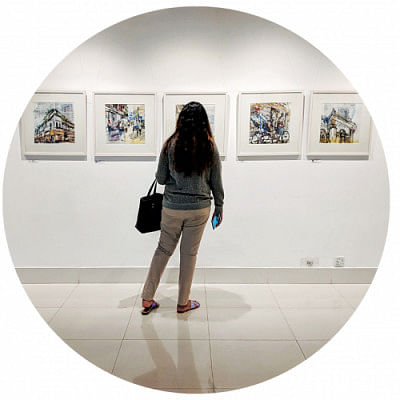Interpreting art as a noob

"This is art," I remember telling myself as I stared at a stack of inflated aluminium cubes. To me, they were just that: much like a barrier, pretty on the eyes. I remember it was called Mirror Barricade. I took a few pictures. That's it.
To me, its significance lay only in its face value. A brochure informed me that the exhibition was meant to revisit examples of the use of inflatables as devices of disruption in art and politics (hence the barricade). There was a giant pink bunny, a white one and a few Ghiblian creatures. I saw them, I liked them. But the same cannot be said about the people with me that day. One of them, Person A, said, "We have helium balloons at home."
Maybe their interpretations had been different, maybe it was a generational gap, but a number of rooms with nothing but giant pneumatic creations certainly wasn't their cup of tea. It wasn't until we reached the giant moon that they finally smiled. A giant moon. Projected onto a spherical screen, with lounge chairs, not unlike a space deck. This made me ask myself, was it personal significance that they were looking for in art?
Perhaps more to their taste would be a certain piece named Comedian. Media: Banana and duct tape. Made to be a true critique of the strangeness of capitalism and art, yet, inadvertently became part of the problem. Person B, when faced with the question, however, was not impressed.
I decided to skip out the money part.
Art is an extremely fluid notion. Keeping in mind that everyone's mind is a vessel of a different shape, the big picture once the colours coalesce is also different to each set of eyes. Nobody gets to define what isn't art, even though contemporary art ventures far beyond what most people would accept to be priceless. Take that eyeglasses incident, for example, there is nothing people won't accept as art.
So when making plans for a visit to a very recent exhibition, I decided on a small experiment. I would 'drop' a piece of glass with beads embedded, and a small card with the name and a few lines of text, and stand at a reasonable distance to see the reaction. We didn't eventually carry it out, but let's speculate. This social-turned-thought experiment could have gone either of two ways: I would be apprehended on vandalism grounds, or I could get my point proven and end the experiment with a phone call that went like, "Nah Ammu, the traffic is insane today. I didn't get lost at the museum."
The truth is, regardless of what this experiment would prove, there's an incredible richness to the world of visual art, regardless of how you interpret it. I believe it is because a lot of modern art does not have easily recognisable subject matter, or the subject matter is more symbolic than literal, making it harder for us to compartmentalise. With this in mind, you can approach each work of art like a scientific discovery: what does this work do that nobody has done before, and how does its form reveal the motivations of its creator(s)? Or maybe, don't approach art with expectations. Modern art doesn't work well that way. It needs purely to be observed. Look at it. Think about what you like and what you don't like about it. Pay attention to the strokes and shades.
Truth is, it still may do nothing for you. And that's okay.
Sarah Wasifa sees life as a math equation: problematic, perhaps with a solution, and maybe sometimes with a sign to tear off a page and start over again. Help her find 'y' at [email protected]

 For all latest news, follow The Daily Star's Google News channel.
For all latest news, follow The Daily Star's Google News channel. 



Comments